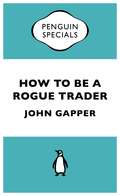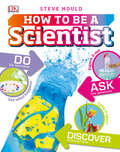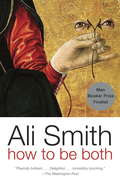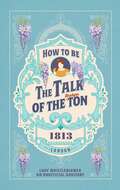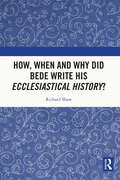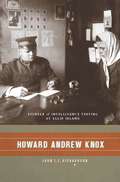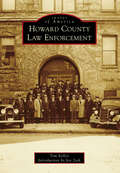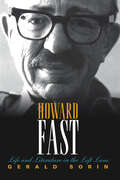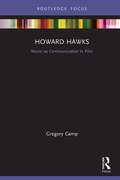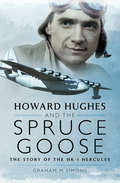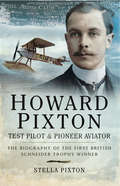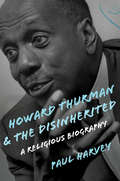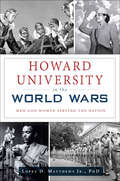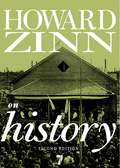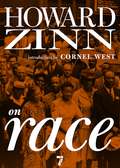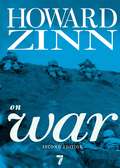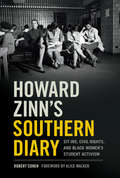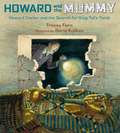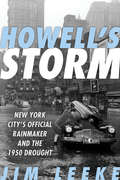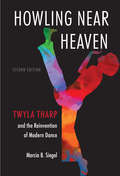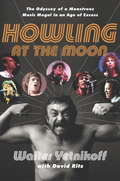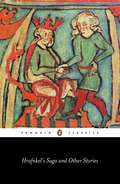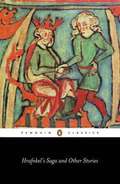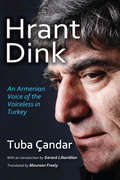- Table View
- List View
How to be a Rogue Trader (Penguin Specials)
by John GapperPenguin Specials are designed to fill a gap. Written to be read over a long commute or a short journey, they are original and exclusively in digital form. This is John Gapper's foray into the world of rogue traders.Unlike most bankers, they are household names: Nick Leeson of Barings, Jerome Kerviel of Societe Generale, John Rusnak of Allied Irish Bank. And now the 31 year-old Kweku Adoboli, who allegedly ran up $2.3bn in losses at UBS. These are the men who have bought banks to their knees and global financial systems to a halt. Each time the banks declare themselves to be innocent victims of a fraud.But why do traders keep on committing apparently senseless crimes, with little benefit apart from higher bonuses and a risk of ending up in prison? And why do banks, which should have learned the tricks of the traders, keep being deceived?In this Penguin Special, the Financial Times' associate editor John Gapper unlocks the mystery by delving into the evolutionary risk-taking instincts of both humans and animals - from yellow-eyed junco sparrows in Arizona to honey-bees. He reveals how banks encourage their traders to evade risk limits, and shows how the rogue traders merely mimic the strategies used by their firms to seem more profitable than they really are.A rogue trader is often an outsider who starts in a lowly role and gambles with a bank's money in a bid to become a star. Gapper traces patterns of behaviour and personality that could be used to catch them before disaster strikes. But do the banks really want to? And are the rogue traders just the symptoms of a financial system gone rogue?
How to be a Scientist (Careers for Kids)
by Steve MouldLearn how to think like a scientist, look at the world in a brand-new way and have tons of fun with science comedian Steve Mould's bold and playful kids science book.Supporting STEM and STEAM education initiatives, How to be a Scientist will inspire kids to ask questions, do activities, think creatively, and discover amazing fun facts! A firm favorite in classrooms and homes alike, this science book for kids has earned itself a permanent spot on many family bookshelves. With more than 40 fun questions, experiments, games, and real-life scenarios that make scientific concepts fun and relevant, it's not hard to see why! Simple activities with undetermined answers encourage curious young readers to find new ways to test ideas. The stories of the great scientists and their discoveries (and failures) are told in an entertaining way to provide even further inspiration for budding young scientists.This educational book has the amazing ability to cover a wide range of ages, so if your children have an age gap this is a fantastic way to get them to engage with each other in a fun and educational way. It is informative, colorful, well written and draws you into its pages with an insatiable appetite for the simpler facts of science. Most of the home science experiments for kids are easy to do with items most people already have around the house, making it super easy to go from idea to execution. Explore, Investigate And Test Your Ideas!Discover the skills it takes to become a scientist. Being a scientist isn't just about wearing a white coat and doing experiments in a lab. It's about exploring, investigating, testing and figuring out how things work. How To Be A Scientist is packed with fun activities and projects that let you answer lots of tricky questions and help to explain the world around you. This kid&’s educational book challenges children to think for themselves and covers topics like:- Weather, making a tornado, the water cycle, how to make a compass- Energy, hot air balloons, electricity, Newton and Einstein- The solar system, making a sundial, creating your own sunrise, phases of the moonHow to be a Scientist (Careers for Kids) is one of four fantastic books in the How to… educational books series, including How To Be A Math Genius, How to Be Good at Math, and How to Make a Better World. Official reviews include: International Literacy Association's Children's Choices 2018 Reading List"Readers will be inspired to learn more about how to think and act like these famous scientists while uncovering deep scientific knowledge they can apply through fun-filled science projects." Minnesota Parent "This mix of classic and unusual science anecdotes and experiments is just the thing for budding STEM/STEAM fans, including tips for learning how to think and act like a scientist with fun activities and simple scientific explanations of biology, anatomy, physics, astronomy, chemistry and more."
How to be both
by Ali SmithSHORT-LISTED FOR THE MAN BOOKER PRIZEPassionate, compassionate, vitally inventive and scrupulously playful, Ali Smith's novels are like nothing else. A true original, she is a one-of-a-kind literary sensation. Her novels consistently attract serious acclaim and discussion--and have won her a dedicated readership who are drawn again and again to the warmth, humanity and humor of her voice. How to be both is a novel all about art's versatility. Borrowing from painting's fresco technique to make an original literary double-take, it's a fast-moving genre-bending conversation between forms, times, truths and fictions. There's a Renaissance artist of the 1460s. There's the child of a child of the 1960s. Two tales of love and injustice twist into a singular yarn where time gets timeless, structural gets playful, knowing gets mysterious, fictional gets real--and all life's givens get given a second chance.A NOTE TO THE READER:Who says stories reach everybody in the same order? This novel can be read in two ways, and the eBook provides you with both. You can choose which way to read the novel by simply clicking on one of two icons--CAMERA or EYES. The text is exactly the same in both versions; the narratives are just in a different order. The ebook is produced this way so that readers can randomly have different experiences reading the same text. So, depending on which icon you select, the book will read: EYES, CAMERA, or CAMERA, EYES. (Your friend may be reading it the other way around.) Enjoy the adventure. (Having both versions in the same file is intentional.)
How to be both
by Ali Smith<P>Passionate, compassionate, vitally inventive and scrupulously playful, Ali Smith's novels are like nothing else. A true original, she is a one-of-a-kind literary sensation. Her novels consistently attract serious acclaim and discussion--and have won her a dedicated readership who are drawn again and again to the warmth, humanity and humor of her voice. <P>How to be both is a novel all about art's versatility. <P>Borrowing from painting's fresco technique to make an original literary double-take, it's a fast-moving genre-bending conversation between forms, times, truths and fictions. <P>There's a Renaissance artist of the 1460s. <P>There's the child of a child of the 1960s. <P>Two tales of love and injustice twist into a singular yarn where time gets timeless, structural gets playful, knowing gets mysterious, fictional gets real--and all life's givens get given a second chance. <P><b>Winner of the 2015 Women's Prize for Fiction <P>SHORT-LISTED FOR THE MAN BOOKER PRIZE</b>
How to be the Talk of the Ton: & Be The Talk Of The Ton
by Lady WhistleblowerShall we promenade? Dear Reader,Welcome to the definitive guide to navigating the social season. Learn about etiquette in all its forms. Within these abundant leaves you will be gifted with all the instruction and patronage necessary to take your place in society. Sort your Dandies from your Rakes, your Merry Andrews from your Bucks. All of the menagerie of beau monde's are contained within. So read on dearest reader and bury oneself in the pool of knowledge that will equip oneself to become the talk of the ton.Yours sincerelyLady Whistleblower
How, When and Why did Bede Write his Ecclesiastical History?
by Richard ShawBede’s Ecclesiastical History is our main source for early Christian Anglo-Saxon England, but how was it written? When? And why? Scholars have spent much of the last half century investigating the latter question – the ‘why’. This new study is the first to systematically consider the ‘how’ and the ‘when’. Richard Shaw shows that rather than producing the History at a single point in 731, Bede was working on it for as much as twenty years, from c. 715 to just before his death in 735. Unpacking and extending the period of composition of Bede’s best-known book makes sense of the complicated and contradictory evidence for its purposes. The work did not have one context, but several, each with its own distinct constructed audiences. Thus, the History was not written for a single purpose to the exclusion of all others. Nor was it simply written for a variety of reasons. It was written over time – quite a lot of time – and as the world changed during that time, so too did Bede’s reasons for writing, the intentions he sought to pursue – and the patrons he hoped to please or to placate.
Howard Andrew Knox: Pioneer of Intelligence Testing at Ellis Island
by John RichardsonHoward Andrew Knox (1885–1949) served as assistant surgeon at Ellis Island during the 1910s, administering a range of verbal and nonverbal tests to determine the mental capacity of potential immigrants. An early proponent of nonverbal intelligence testing (largely through the use of formboards and picture puzzles), Knox developed an evaluative approach that today informs the techniques of practitioners and researchers. Whether adapted to measure intelligence and performance in children, military recruits, neurological and psychiatric patients, or the average job applicant, Knox's pioneering methods are part of contemporary psychological practice and deserve in-depth investigation.Completing the first biography of this unjustly overlooked figure, John T. E. Richardson, former president of the International Society for the History of the Neurosciences, takes stock of Knox's understanding of intelligence and his legacy beyond Ellis Island. Consulting published and unpublished sources, Richardson establishes a chronology of Knox's life, including details of his medical training and his time as a physician for the U.S. Army. He describes the conditions that gave rise to intelligence testing, including the public's concern that the United States was opening its doors to the mentally unfit. He then recounts the development of intelligence tests by Knox and his colleagues and the widely-discussed publication of their research. Their work presents a useful and extremely human portrait of psychological testing and its limits, particularly the predicament of the people examined at Ellis Island. Richardson concludes with the development of Knox's work in later decades and its changing application in conjunction with modern psychological theory.
Howard County Law Enforcement (Images of America)
by Tom Kelley Jon ZeckSince the 1880s, when a Howard County sheriff's deputy shot the mayor of Kokomo during the commission of a burglary, Howard County law enforcement officers have played an important role in the community's history. Police officers, deputies, and troopers cleared rowdies out of the junction neighborhood, walked downtown beats, rescued tornado survivors, quelled civil disturbances, cleaned up tragic accidents, and solved grisly murders. By the mid-1940s, a new generation of war veterans came home with a spirit of progress and experience in leadership. The foundation of compassion, perseverance, and integrity they established in Howard County law enforcement has defined their unswerving commitment to the safety of the community and to one another. Images of America: Howard County Law Enforcement tells their story.
Howard Fast: Life and Literature in the Left Lane (The\modern Jewish Experience Ser.)
by Gerald SorinHoward Fast's life, from a rough-and-tumble Jewish New York street kid to the rich and famous author of close to 100 books, rivals the Horatio Alger myth. Author of bestsellers such as Citizen Tom Paine, Freedom Road, My Glorious Brothers, and Spartacus, Fast joined the American Communist Party in 1943 and remained a loyal member until 1957, despite being imprisoned for contempt of Congress. Gerald Sorin illuminates the connections among Fast's Jewishness, his writings, and his left-wing politics and explains Fast's attraction to the Party and the reasons he stayed in it as long as he did. Recounting the story of his private and public life with its adventure and risk, love and pain, struggle, failure, and success, Sorin also addresses questions such as the relationship between modern Jewish identity and radical movements, the consequences of political myopia, and the complex interaction of art, popular culture, and politics in 20th-century America.
Howard Hawks: Music as Communication in Film (Filmmakers and Their Soundtracks)
by Gregory CampKnown for creating classic films including His Girl Friday, The Big Sleep, Bringing Up Baby, and Gentlemen Prefer Blondes, Howard Hawks is one of the best-known Hollywood ‘auteurs’, but the important role that music plays in his films has been generally neglected by film critics and scholars. In this concise study, Gregory Camp demonstrates how Hawks' use of music and musical treatment of dialogue articulate the group communication that is central to his films. In five chapters, Camp explores how the notion of 'music' in Hawks' films can be expanded beyond the film score, and the techniques by which Hawks and his collaborators (including actors, screenwriters, composers, and editors) achieve this heightened musicality.
Howard Hughes and the Spruce Goose: The Story of the H-K1 Hercules
by Graham M. SimonsHoward Hughes' life ambition was to make a significant contribution to the field of aviation development. But the monumental folly of his endeavours on the H-KI Hercules meant that he came to be known and remembered to a great extent for all the wrong reasons. The 'Spruce Goose' (a name Hughes detested) became a product of his wild fixation on perfection and scale. Once completed, it was the largest flying machine ever built. Its wingspan of 320 feet remains the largest in history. Yet it only completed one flight; flying for a mile on its maiden voyage above Long Beach Harbour, before being consigned to the history books as a failure.Experienced author Graham M. Simons turns his attention to the production process that saw this colossus take shape. In words and images, all aspects of this process are illustrated. We have shots taken during the initial design period, images of the craft under construction, and photographs taken at the test flights. In addition, Simons has been gifted access to the highly prized and rarely seen aircraft manual produced for the aircraft, content from which has been extracted and used to supplement the narrative.The book goes on to explore the political issues that sprung up as a result of Hughes' endeavours, looking into the Senate War Investigations Committee's findings which explored the extent to which government funds had been utilised in the development and construction of the airship, adding a whole new layer of controversy to the proceedings.
Howard Pixton: Test Pilot & Pioneer Aviator: The Biography of the First British Schneider Trophy Winner
by Stella PixtonThis book is a truly remarkable account that captures the atmosphere, thrills and danger of the pioneering days of aviation. Howard Pixton was flying for A V Roe at Brooklands in 1910 when S F Cody at Laffan's Plain tried to persuade him to join him. But in 1911 he test flew A V Roe's 'tractor biplane, the forerunner of the 504. By now acknowledged as the first professional test pilot, he left A V to join Bristols and for two years demonstrated new models to dignitaries across Europe.In 1913 he joined Tommy Sopwith and in 1914 he became the first Briton in a British plane to win an international race, the coveted Schneider Trophy. This gave Britain air supremacy and Howard was feted as the finest pilot in the World. Sopwith's Tabloid aircraft developed into the 'Pup', and then into the 'Camel'. Throughout The Great War Pixton test flew many of the rapid evolving designs.For a biography of an early aviation pioneer of the top rank, this book cannot be bettered.
Howard Thurman and the Disinherited: A Religious Biography (Library of Religious Biography (LRB))
by Paul HarveyTeacher. Minister. Theologian. Writer. Mystic. Activist. No single label can capture the multiplicity of Howard Thurman&’s life, but his influence is written all over the most significant aspects of the Civil Rights movement. In 1936, he visited Mahatma Gandhi in India and subsequently brought Gandhi&’s concept of nonviolent resistance across the globe to the United States. Later, through his book Jesus and the Disinherited, he foresaw a theology of American liberation based on the life of Jesus as a dispossessed Jew under Roman rule. Paul Harvey&’s biography of Thurman speaks to the manifold ways this mystic theologian and social activist sought to transform the world to better reflect &“that which is God in us,&” despite growing up in the South during the ugliest years of Jim Crow. After founding one of the first intentionally interracial churches in the country—The Church for the Fellowship of All Peoples in San Francisco—he shifted into a mentorship role with Martin Luther King Jr. and other Civil Rights leaders. He advised them to incorporate more inward seeking and rest into their activism, while also thinking of their struggle for racial equality in a more cosmopolitan, universalist manner. Few historical figures represent such diverse parts of the American religious tradition as Howard Thurman did. By telling the story of his religious lives, Paul Harvey gives the reader a window into many of the main currents of twentieth-century American religious expression.
Howard University in the World Wars: Men and Women Serving the Nation (Military)
by Ph.D. Lopez D. Matthews Jr.Despite African Americans' lack of political, social and economic equality in the United States, the students of Howard University answered the call to service in both world wars. Howard supported its men and women in the quest to serve their nation. The university started an army training program during the First World War, and Howard faculty, staff and students pushed the War Department to begin an officer training school for African Americans. The university organized a Reserve Officer Training program in the interwar years, the first at an HBCU. Many of the famed Tuskegee Airmen of World War II were trained first at Howard. Based on a collection of letters sent by Howard students and alumni to the university, historian and archivist Lopez D. Matthews illuminates their wartime experiences.
Howard Zinn on History
by Howard ZinnHoward Zinn began work on his first book for his friends at Seven Stories Press in 1996, a big volume collecting all his shorter writings organized by subject. The themes he chose reflected his lifelong concerns: war, history, law, class, means and ends, and race. Throughout his life Zinn had returned again and again to these subjects, continually probing and questioning yet rarely reversing his convictions or the vision that informed them. The result was The Zinn Reader. Five years later, starting with Howard Zinn on History, updated editions of sections of that mammoth tome were published in inexpensive stand-alone editions. This second edition of Howard Zinn on History brings together twenty-seven short writings on activism, electoral politics, the Holocaust, Marxism, the Iraq War, and the role of the historian, as well as portraits of Eugene Debs, John Reed, and Jack London, effectively showing how Zinn's approach to history evolved over nearly half a century, and at the same time sharing his fundamental thinking that social movements--people getting together for peace and social justice--can change the course of history. That core belief never changed. Chosen by Zinn himself as the shorter writings on history he believed to have enduring value--originally appearing in newspapers like the Boston Globe or the New York Times; in magazines like Z, the New Left, the Progressive, or the Nation; or in his book Failure to Quit--these essays appear here as examples of the kind of passionate engagement he believed all historians, and indeed all citizens of whatever profession, need to have, standing in sharp contrast to the notion of "objective" or "neutral" history espoused by some. "It is time that we scholars begin to earn our keep in this world," he writes in "The Uses of Scholarship." And in "Freedom Schools," about his experiences teaching in Mississippi during the remarkable "Freedom Summer" of 1964, he adds: "Education can, and should, be dangerous."
Howard Zinn on Race
by Howard Zinn Cornel WestHoward Zinn on Race is Zinn's choice of the shorter writings and speeches that best reflect his views on America's most taboo topic. As chairman of the history department at all black women's Spelman College, Zinn was an outspoken supporter of student activists in the nascent civil rights movement. In "The Southern Mystique," he tells of how he was asked to leave Spelman in 1963 after teaching there for seven years. "Behind every one of the national government's moves toward racial equality," writes Zinn in one 1965 essay, "lies the sweat and effort of boycotts, picketing, beatings, sit-ins, and mass demonstrations." He firmly believed that bringing people of different races and nationalities together would create a more compassionate world, where equality is a given and not merely a dream. These writings, which span decades, express Zinn's steadfast belief that the people have the power to change the status quo, if they only work together and embrace the nearly forgotten American tradition of civil disobedience and revolution. In clear, compassionate, and present prose, Zinn gives us his thoughts on the Abolitionists, the march from Selma to Montgomery, John F. Kennedy, picketing, sit-ins, and, finally, the message he wanted to send to New York University students about race in a speech he delivered during the last week of his life.
Howard Zinn on War
by Howard ZinnHoward Zinn began work on his first book for his friends at Seven Stories Press in 1996, a big volume collecting all his shorter writings organized by subject. The themes he chose reflected his lifelong concerns: war, history, law, class, means and ends, and race. Throughout his life Zinn had returned again and again to these subjects, continually probing and questioning yet rarely reversing his convictions or the vision that informed them. The result was The Zinn Reader. Five years later, starting with Howard Zinn on History, updated editions of sections of that mammoth tome were published in inexpensive stand-alone editions. This second edition of Howard Zinn on War is a collection of twenty-six short writings chosen by the author to represent his thinking on a subject that concerned and fascinated him throughout his career. He reflects on the wars against Iraq, the war in Kosovo, the Vietnam War, World War II, and on the meaning of war generally in a world of nations that can't seem to stop destroying each other. These readings appeared first in magazines and newspapers including the Progressive and the Boston Globe, as well as in Zinn's books, Failure to Quit, Vietnam: The Logic of Withdrawal, The Politics of History, and Declarations of Independence. Here we see Zinn's perspective as a World War II veteran and peace activist who lived through the most devastating wars of the twentieth century and questioned every one of them with his combination of integrity and historical acumen. In his essay, "Just and Unjust War," Zinn challenges us to fight for justice "with struggle, but without war." He writes in "After the War (2006) that while governments bring us into war, "their power is dependent on the obedience of the citizenry. When that is withdrawn, governments are helpless." In Howard Zinn on War, his message is clear: "The abolition of war has become not only desirable but absolutely necessary if the planet is to be saved. It is an idea whose time has come."
Howard Zinn's Southern Diary: Sit-ins, Civil Rights, and Black Women's Student Activism
by Robert CohenThe activist and author of A People&’s History of the United States records an in-depth and personal account of the Civil Rights Movement in Atlanta. During the Civil Rights Movement of the 1960s, students of Spelman College, a black liberal arts college for women, were drawn into the historic protests occurring across Atlanta. At the time, Howard Zinn was a history professor at Spelman and served as an adviser to the Student Nonviolent Coordinating Committee. Zinn mentored many of Spelman&’s students fighting for civil rights at the time, including Alice Walker and Marian Wright Edelman. Zinn&’s involvement with the Atlanta student movement and his closeness to Spelman&’s leading activists gave him an insider&’s view of the political and intellectual world of Spelman, Atlanta University, and the SNCC. He recorded his many insights and observations of the time in his Spelman College diary. Robert Cohen presents Zinn&’s diary in full along with a thorough historical overview and helpful contextual notes. It is a fascinating historical document of the free speech, academic freedom, and student rights battles that rocked Spelman and led to Zinn&’s dismissal from the college in 1963 for supporting the student movement.
Howard and the Mummy: Howard Carter and the Search for King Tut's Tomb
by Tracey FernA captivating picture book biography about Howard Carter, the discoverer of King Tut's tomb in 1922.Howard Carter was obsessed with mummies. He met his first when he was a boy in England and lived near a mansion filled with Egyptian artifacts. Howard dreamed of discovering a mummy himself—especially a royal mummy in its tomb, complete with all its treasures. When he was seventeen, he took a job with the Egypt Exploration Fund and was sent to Egypt to learn about archaeology and excavation sites. And his mummy hunt was on! Howard discovered many amazing artifacts, but he searched for years before coming upon the most famous mummy of all, King Tut. With stunning artwork from Boris Kulikov, and an informative and funny text from Tracey Fern, Howard and the Mummy is a true story about the challenges of discovery and the rewards of perseverance.
Howell's Storm: New York City's Official Rainmaker and the 1950 Drought
by Jim LeekeMore than half a century ago, New York City felt the increasing effects of drought, which lasted throughout 1949 and into 1950. By February, the desperate city had to try something different. Mayor William O'Dwyer hired a municipal rainmaker. Dr. Wallace E. Howell was an inspired choice. The handsome, 35-year-old Harvard-educated meteorologist was the ideal scientist—soft-spoken, modest and articulate. No fast-talking prairie huckster, he took credit for nothing he couldn't prove with sound empirical data. Howell's meticulous nature often baffled jaded New Yorkers. Over the next year, his leadership of a small ground and air armada, and his unprecedented scientific campaign to replenish the city's Catskills reservoirs, captured the imagination of the world. New York's cloud-seeding and rainmaking efforts would remain the stuff of legends—and controversy—for decades.This is the first in-depth look at New York City's only official rainmaker—an unintentional celebrity, dedicated scientist and climate entrepreneur, whose activities stirred up controversy among government officials, meteorologists, theologians, farmers and resort owners alike.
Howling Near Heaven: Twyla Tharp and the Reinvention of Modern Dance
by Marcia B. SiegelFor more than five decades, Twyla Tharp has been a phenomenon in American dance, a choreographer who not only broke the rules but refused to repeat her own successes. Tharp has made movies, television specials, and nearly one hundred riveting dance works. Her dance show Movin’ Out ran on Broadway for three years and won Tharp a Tony award for Best Choreography. Howling Near Heaven is the only in-depth study of Twyla Tharp’s unique, restless creativity. This second edition features a new forward that brings the account of Tharp’s work up to date and discusses how dance and dance-making in the United States have changed in recent years. This is the story of a choreographer who refused to be pigeonholed and the dancers who accompanied her as she sped across the frontiers of dance.
Howling at the Moon: The Odyssey of a Monstrous Music Mogul in an Age of Excess
by Walter Yetnikoff David RitzShow biz memoir at its name-dropping, bridge-burning, profane best: the music industry&’s most outspoken, outrageous, and phenomenally successful executive delivers a rollicking memoir of pop music&’s heyday.During the 1970s and '80s the music business was dominated by a few major labels and artists such as Michael Jackson, Bruce Springsteen, the Rolling Stones, Bob Dylan, Billy Joel, Paul Simon, Barbra Streisand and James Taylor. They were all under contract to CBS Records, making it the most successful label of the era. And, as the company&’s president, Walter Yetnikoff was the ruling monarch. He was also the most flamboyant, volatile and controversial personality to emerge from an industry and era defined by sex, drugs and debauchery. Having risen from working-class Brooklyn and the legal department of CBS, Yetnikoff, who freely admitted to being tone deaf, was an unlikely label head. But he had an uncanny knack for fostering talent and intimidating rivals with his appalling behavior—usually fueled by an explosive combination of cocaine and alcohol. His tantrums, appetite for mind-altering substances and sexual exploits were legendary. In Japan to meet the Sony executives who acquired CBS during his tenure, Walter was assigned a minder who confined him to a hotel room. True to form, Walter raided the minibar, got blasted and, seeing no other means of escape, opened a hotel window and vented his rage by literally howling at the moon. In Howling at the Moon, Yetnikoff traces his journey as he climbed the corporate mountain, danced on its summit and crashed and burned. We see how Walter became the father-confessor to Michael Jackson as the King of Pop reconstructed his face and agonized over his image while constructing Thriller (and how, after it won seven Grammies, Jackson made the preposterous demand that Walter take producer Quincy Jones&’s name off the album); we see Walter, in maniacal pursuit of a contract, chase the Rolling Stones around the world and nearly come to blows with Mick Jagger in the process; we get the tale of how Walter and Marvin Gaye—fresh from the success of &“Sexual Healing&”—share the same woman, and of how Walter bonds with Bob Dylan because of their mutual Jewishness. At the same time we witness Yetnikoff&’s clashes with Barry Diller, David Geffen, Tommy Mottola, Allen Grubman and a host of others. Seemingly, the more Yetnikoff feeds his cravings for power, sex, liquor and cocaine, the more profitable CBS becomes—from $485 million to well over $2 billion—until he finally succumbs, ironically, not to substances, but to a corporate coup. Reflecting on the sinister cycle that left his career in tatters and CBS flush with cash, Yetnikoff emerges with a hunger for redemption and a new reverence for his working-class Brooklyn roots.Ruthlessly candid, uproariously hilarious and compulsively readable, Howling at the Moon is a blistering You&’ll Never Eat Lunch in this Town Again of the music industry.
Hrafnkel's Saga and Other Icelandic Stories
by AnonymousWritten around the thirteenth century AD by Icelandic monks, the seven tales collected here offer a combination of pagan elements tightly woven into the pattern of Christian ethics. They take as their subjects figures who are heroic, but do not fit into the mould of traditional heroes. Some stories concern characters in Iceland - among them Hrafknel's Saga, in which a poor man's son is murdered by his powerful neighbour, and Thorstein the Staff-Struck, which describes an ageing warrior's struggle to settle into a peaceful rural community. Others focus on the adventures of Icelanders abroad, including the compelling Audun's Story, which depicts a farmhand's pilgrimage to Rome. These fascinating tales deal with powerful human emotions, suffering and dignity at a time of profound transition, when traditional ideals were gradually yielding to a more peaceful pastoral lifestyle.
Hrafnkel's Saga and Other Icelandic Stories
by Hermann PalssonTHE stories in this volume date from the thirteenth century, the Golden Age of saga writing,
Hrant Dink: An Armenian Voice of the Voiceless in Turkey
by Tuba CandarThis is the biography of Hrant Dink, a Turkish-Armenian journalist and political activist. He worked for the democratic rights of all Turkish citizens, including the right to speak freely about the genocide of Anatolia's Armenians in 1915. As a result of his activism, Dink was assassinated by Turkish nationalists in 2007.As founder and editor-in-chief of the bilingual Turkish-Armenian newspaper, Agos, in 1996, Dink was the first secular voice of Turkey's silenced Christian-Armenian minority. He fought for the democratization of the Turkish political system. This was a risky undertaking, in a country where Armenians live as closed communities; it was also unprecedented in Turkey. Dink was prosecuted three times for "insulting and denigrating Turkishness" and ultimately convicted.The biography is written as an oral history, and assembles a mosaic of memories as told by Dink's family, friends, and comrades. Dink's own "voice," in the form of his writings, is also included. Originally published in Turkey, it is now available for an English-speaking audience on the 100th anniversary of the Armenian genocide.
